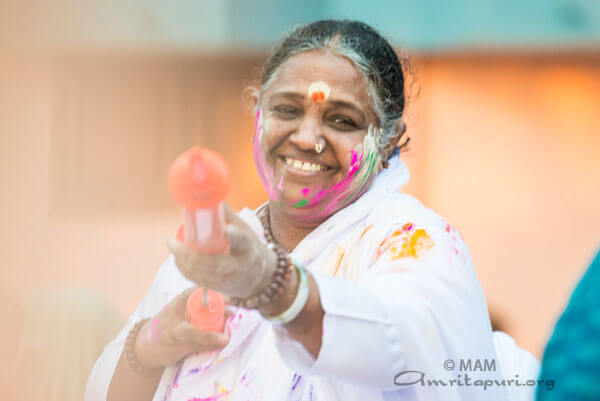Holi is an extremely popular festival of India and it is common to all sections of society with it’s origins going back to ancient times. Also known as ‘Holika’, it has been mentioned in very early religious texts such as Jaimini’s Purva mimamsa-sutras and others. It must have therefore existed several centuries before the common era and has been common all over India for millenia.
Amma on Holi
“Holi is a symbol of joy and celebration. May your life be filled with the colour of bliss. Once you apply the paints, everything looks the same. Similarly when you apply the paint of love to the mind, all differences disappear, we become one and we will be able to move ahead in unity. Holi reminds us about the greatness of faith. Prahlada was sitting on the lap of Holika, but the fire couldn’t harm him1. That was due to the unshakeable faith Prahlada had in the Lord. May my children’s faith be similarly formed. Amma prays to the Paramatman that this be so.”
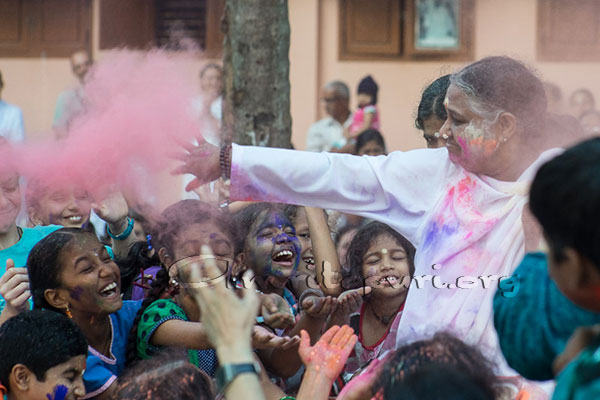
The Festival
In India festivals are the fabric of scoiety that binds it together creating a happy and harmonious atmosphere. All the festivals carry within them social, religious and spiritual messages. Even so in this scheme of things Holi has a special place and purpose. In most cases festivals involve fasting and other austerities but in the case of Holi the opposite is the case. It is the time of the year when we are given free reign to express our desires and release some pressure by acting out in a controlled manner what has been building inside us for the rest of the year. Like a pressure cooker might explode if not taken care to let out some steam, likewise the festival of Holi serves the same in our psychological make-up. In this way we clean the slate in order to begin the new year afresh without stagnated and repressed vasanas pulling us down.
The purpose of Holi is not to celebrate only the positive emotions but in some cases it serves as a legitimate way of expressing negative emotions might also be called for. In such a tradition, on Holi, it is not completely unheard of to slap someone gently who has been a source of consternation to us during the rest of the year. Naturally this should not be used as an excuse for wanton eratic behaviour and should be done with a spirit of good humor as Holi is after a festival of friendhsip and joy, with the express purpose of healing society and preventing negative tendencies from overwhelming us. Another aspect of Holi is to help us break the barriers we have built around ourselves and our ego. Usually we are very protective of our personal space and will not let anyone violate that. During Holi such rules do not apply and the whole purpose is to behave in such a way as to bring down those walls in ourself and others and let go. Suddenly there is no difference between us and others. We slip into a state of oneness in which everyone is equal. This is the special beauty of Holi.
Worship of fire is also an important part of Holi as in the this process we offer our vasanas to Agni in order to trancend them eventually. Worshipping the fire during Holi also ushers in the warm season ashead as we move to the new year, marking the end of winter and the abundance of the upcoming spring harvest season. The colours of Holi are also a reflection of our joyful emotions and desires beeing now freely expressed. In the olden days the colours themselves that were used were natural and organic thus serving the dual purpose of being healthy for the body as well as healing our psyche. Nowadays this is not the case as the artificial colours we use are rather harmful and even toxic. The ayurvedic principle has been lost.
Like all Indian and Hindu festivals, Holi is inextricably linked to mythical tales and commemorates the victory of good over evil. There are at least three legends that are directly associated with the festival of colors: the Holika-Hiranyakashipu-Prahlad episode, Lord Shiva’s killing of Kamadeva, and the story of the ogress Dhundhi.
Story of Prahlad
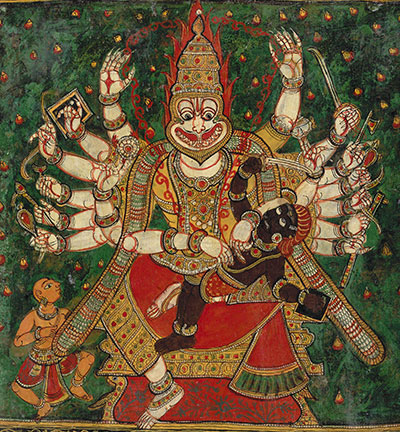
Hiranyakashipu was king of the asuras. Hiranyakashipu’s brother had been slain by Lord Vishnu for terrorising gods and goddesses. As a result, Hiranyakashipu wanted to destroy Lord Vishnu and keep the other gods subdued. He told his soldiers to crush all those who worshipped Vishnu, but Vishnu protected his devotees. Hiranyakashipu thought to himself, “I will have to match my powers with Vishnu’s to rule over the three worlds”.
So, he began performing tapas (severe austerities). When he was thus occupied, the gods ransacked his city and destroyed his palace. Hiranyakashipu’s wife, who was expecting a child, was sent to Sage Narada’s hermitage. There, she learned about religion and the glory of Lord Vishnu under him. Narada taught the Queen that Lord Vishnu was the soul of all created things and that he was present everywhere. The child within her, Prahlad, absorbed all this knowledge too.
Meanwhile, Hiranyakashipu’s austerities pleased Lord Brahma who said, “Arise Hiranyakashipu. Any boon that you ask of Me shall be yours”. Hiranyakashipu said, “I wish that my death be not caused by man or beast, with a weapon or without a weapon, during day or night, indoors or outdoors, on earth or in the sky. Grant me the undisputed lordship over the material world”. Lord Brahma granted him the boon.
Hiranyakashipu then brought his wife back to his city where Prahlad was born. Hiranyakashipu, with his new powers, renewed his hostilities against Vishnu and His followers. He declared, “There is none stronger than I. I am the lord of the three worlds. I shall be worshipped as such”.
In the meantime, Prahlad was growing up and was the apple of Hiranyakashipu’s eye. He asked Prahlad, “Son, tell me: what do you think is the best thing in life?” To which Prahlad replied, “To renounce the world and seek refuge in Vishnu.” Hearing this, Hiranyakashipu laughed. He called aside his son’s teacher and said to him, “Guard him closely. I think that the followers of Vishnu are secretly influencing him. Do not let him out of your sight!”
After many months, his teacher said, “Prahlad, I think you are now ready to meet your father.” When brought before his father, Hiranyakashipu asked him, “You have been with your Guru a long time! What have you learnt?” Prahlad calmly replied, “I have learnt that the most worthwhile occupation for anyone is the worship of Lord Vishnu.”
When Hiranyakashipu heard this reply, he became very angry: “O accursed child! Who taught you such perverse things?” Unperturbed, Prahlad replied, “Lord Vishnu. He reveals Himself to all who are devoted to Him.”
Hearing this, Hiranyakashipu shouted angrily, “This boy must not live! Take him away and kill him! Kill this vilest enemy disguised as my son. Poison him or attack him when he sleeps but kill him!”
The soldiers attacked Prahlad when Prahlad was meditating on Lord Vishnu, but their weapons could not touch Prahlad. Deadly snakes were let loose on Prahlad, but their fangs turned impotent. Mighty elephants could not trample him. He was pushed off a cliff but Prahlad was unharmed.
In desperation, Hiranyakashipu had him fed with poison but it transformed into nectar in Prahlad’s mouth.
It was on this day that Holika, Hiranyakashipu’s sister who had a boon to brave fire without being hurt, tried to kill Prahlad by taking him on her lap and sitting on a burning pyre of wood. Holika was burnt to ashes while Prahlad remained unscathed!
Thus, the Holi festival signifies the burning of self-conceit, selfishness, greed, lust, hatred and all other negative tendencies and actions, and the victory of righteous forces over demonic forces.
In the case of Prahlad his father was unimaginably cruel towards him, yet his faith gave him shelter and protected him. The monstrosity of Hiranyakashipu was more than most could endure but Prahlad kept praying to the Lord who eventually in the form of Narasinmha, destroyed Hiranyakashipu and installed Prahlad on the throne who then went on to rule wisely for many years.
he moral of this story is that whatever adversities life may bring forth our faith should remain unwavering.
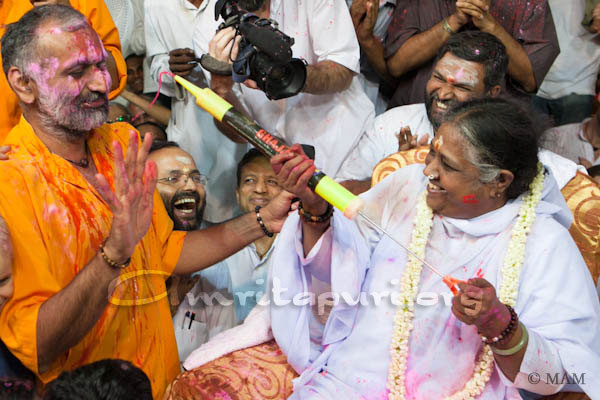
The Rituals
There are practically no religious observances such as fasting or worship on Holi. Generally, a log of wood will be kept in a prominent public place on the Vasantapanchami day (Magha Sukla Panchami), almost 40 days before the Holi festival. An image of Holika with child Prahlad on her lap is also kept on the log. Holika’s image is made of combustible materials whereas Prahlad’s image is made of non-combustible ones. People go on throwing twigs and other combustible material onto the log as it burns. On the night of Phalguna Purnima, it is set alight in a simple ceremony during which the Raksoghna mantras of the Rigveda (4.4.1-15; 10.87.1-25 and so on) are sometimes chanted to ward off all evil spirits. Coconuts and coins are also thrown into this bonfire. The next morning the ashes from the bonfire are collected as prasad (consecrated material) and smeared on the limbs of the body. Singed coconuts, if any, are also collected and eaten.
In some houses, the image of Kamadeva (the god of Desire) is kept in the yard and a simple worship is offered. A mixture of mango blossoms and sandalwood paste is partaken as prasad. The day, Phalgun Krishna pratipada, is observed as a day of revelry during which people throw gulal or coloured water or perfumed coloured powder on each other.
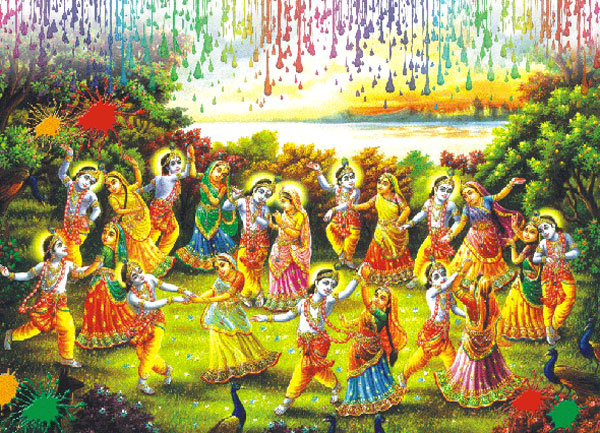
Holi In Bengal
The people of Bengal observe this festival in a quiet and dignified manner as Dolapurnima or Dolayatra (the festival of the swing). The festival, said to have been initiated by King Indradyumna in Vrindavana, is spread over 3 or 5 days, starting from the sukla Chaturdasi of Phalguna. The main features of this festival are a celebration in honour of Agni and the worship of Govinda (Krishna), an image of whom is placed on a swing. The swing is to be rocked 21 times at the end of the festival. Also, the fire kindled on the first day is to be preserved till the last day.
The day is also celebrated as the birthday of Sri Krishna Chaitanya (A.D. 1486-1533).
Other folklore associated with Holi
Holi was, at first, a ritual performed by married women for the happiness and well-being of their families. They worshipped the full moon deity. Thus the full moon festival of Holika gradually became a festival of merrymaking, announcing the commencement of the spring season. Here we see how beatifully the Indian festivals entwine with the natural cycles marking important advents of the solar year. All the festivals are co-ordinated in such a manner as to give people a feeling of participating in a cycle larger than themselves and in so helping to tune in with the cosmic forces inherent in nature.
The following perhaps explains the other names of this festival: Vasanta-Mahotsava and Kama-Mahotsava. According to the stories in the Puranas and various local legends, this day is important for three reasons. It was on this day that Lord Siva opened his third eye and reduced Kamadeva to ashes. It was also on this day that an ogress called Dhundhi, who was troubling the children in the kingdom of Prthu (or Raghu), was made to run for her life, by the shouts and pranks of the mischievous boys. Though she had secured several boons that made her almost invincible, the noise, shouts, abuses and pranks of boys became a chink in her armour due to a curse from Lord Siva. The day itself came to be called “Adada” or “Holika” since then.
Lord Krishna and Holi
The stories of Sri Krishna’s boyhood pranks which so delighted the gopis (cowherd maids) of Vrindavan also form the essence of Holi. Though older than Krishna, the gopis were so charmed by Sri Krishna’s play that they themselves became like children again. Sri Krishna and the gopis are depicted as celebrating Holi in the hamlets of Gokula, Barsana and Vrindavan, bringing them alive with their mischief and youthful pranks. Holi was Krishna and the gopi’s celebration of Love. This teasing, affectionate panorama of feeling and colour has been captured and immortalized in the songs on Holi.
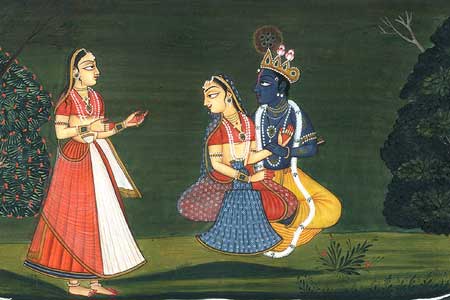
Holi is also celebrated in memory of the immortal love of Lord Krishna and Radha. The young Krishna would complain to his mother Yashoda about why Radha was so fair and he so dark. Yashoda advised him to apply colour on Radha’s face and see how her complexion would change. In the legends of Krishna as a youth he is depicted playing all sorts of pranks with the gopis or cowgirls. One prank was to throw colored powder all over them. So at Holi, images of Krishna and his consort Radha are often carried through the streets. Holi is celebrated with great enthusiasm in the villages around Mathura, the birth-place of Krishna.
So let us also join together free from the binds of our self-created barriers and feel the happiness of Holi, forgetting ourselves and glimpsing the eternal joy residing in our soul.

